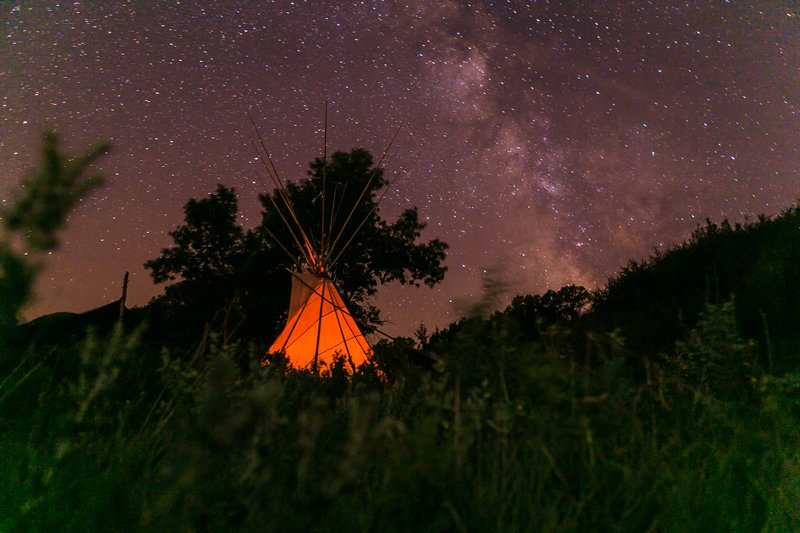Standing Rock Sioux
Source: A Guide to Tribal Nations, Oceti Sakowin Homelands, South Dakota
WELCOME to the land of the Lakota, Dakota and Nakota. There are 9 Native American tribes that call South Dakota home and each of them has a unique story to tell. Working together they welcome visitors into their communities in order to educate and share.
Standing Rock Sioux Tribe
Covering 2.3 million acres the Standing Rock Indian Reservation is the fifth largest reservation in the United States. It stretches across the expansive tallgrass prairie, rolling hills and buttes that border the Missouri River.
Lake Oahe, a Missouri river reservoir, is on the east side of Standing Rock. The Grand River is to the south and the Cannon Ball River is to the north. The reservation includes lands in South Dakota and North Dakota.
Standing Rock Reservation takes its name from a natural formation that resembles a woman with a child on her back. Today this sacred stone stands on a monument outside the Standing Rock Agency’s office in Fort Yates, ND.
The reservation is home to two bands of the Lakota Nation: the Sihasapa (or Blackfoot) and the Hunkpapa (or Campers at the Horn). It is also home to two bands of Dakota, including the Upper Yanktonai (called the Ihanktonwana or Little End Village) and the Lower Yanktonai (called the Hunkatina or Cut Heads).
The reservation was established in July 1873 by the Fort Laramie Treaty of 1873 by the Fort Laramie Treaty of 1868, which broke up the Great Sioux Nation into smaller reservations.
The Hunkpapa and Sihasapa people were known as the horsemen of the plains and primarily hunted buffalo for their needs. The Yanktonai were a river-plains people who did some farming and buffalo hunting.
Standing Rock is the birthplace of (bold) Sitting Bull (1831-1890), one of the most widely recognized Native American historical figures. Known in his language as Tatanka Iyotake. Sitting Bull was a medicine man and an Itancan, (Leader of the People). He was born along the Grand River and lived the traditional lifestyle of his people. In his lifetime he fought to preserve and protect the ways of the people and stood firm against all attempts by the US government to buy land sacred to the Lakota and Dakota people and to being relocated to the reservation set aside for the Nation.
Sitting Bull was killed on December 15, 1890 during an attempt to arrest him. Two burial sites memorialize Sitting Bull: the original burial site located at FORT YATES and the site to where the grave was allegedly relocated across the Missouri River from MOBRIDGE. At the Fort Yates site, a rock and bronze sign honors Sitting Bull. A bust carved by Korzcak Ziolkowski honors Sitting Bull at the site near Mobridge. This site overlooks the western bank of the Missouri River on the eastern boundary of the reservation.
Just north of Mobridge on Highway 1806 the INDIAN MEMORIAL AREA is home to the JEDEDIAH SMITH HISTORICAL MONUMENT, which describes the life and accomplishments of this famous explorer.
In addition to its rich culture and history, Standing Rock offers great scenic drives and recreational opportunities.
The STANDING ROCK NATIONAL NATIVE AMERICAN SCENIC BYWAY runs along historic Highway 1806 and Highway 24 for 86 miles. It crosses the lands of the Lakota and Dakota people, who preserve the history of several explorers, trappers and chiefs who were essential in the shaping of the American West.
Memorial markers, interpretive signs and monuments commemorate the heritage of the Lakota and Dakota nations, allowing visitors to learn history from the Native American and early settlers’ points of view. Standing Rock offers historical step-on guided tours along the scenic byway, covering the lives of Sitting Bull, Gall, Two Gun Hart, Moustache Maude, Hugh Glass, Jim Bridger and Jedediah Smith and how they made history on the Standing Rock Reservation.
Standing Rock offers an abundance of water recreation on Lake Oahe. THE BAY located near Grand River Casino and Resort west of Mobridge and PRAIRIE KNIGHTS CASINO AND RESORT near Fort Yates, provide RV hookups, camping areas and ample space for boating and fishing.
POINTS OF INTEREST AND ATTRACTIONS
In the town of Fort Yates, ND overlooking the Missouri River, STANDING RCK MONUMENT is said to represent the petrified from of a woman and her child.
SITTING BULL AND SACAGAWEA MONUMENTS overlook the Missouri River and stand in a remote spot on SD Highway 1806, two miles southwest of Mobridge. Many believe this to be the final resting place of Native American spiritual and social leader Sitting Bull.
SITTING BULL VISITOR CENTER is located on the Sitting Bull College Campus in Fort Yates, ND. The center offers useful information regarding local events, places to visit and special events.
The SITTING BULL COLLEGE BOOKSTORE & BOUTIQUE is located on campus in the Sitting Bull College Science & Technology Center. The boutique offers a variety of clothes, jewelry, arts & crafts and star quilts.
GRAND RIVER CASINO AND RESOURT is located near Mobridge and offers a variety of gaming options, gift shoop, lodging and restaurant.
PRAIRIE KNIGHTS CASINO AND RESORT is located at o7932 Hwy 24, offering a wide variety of high-stakes gaming options, spacious hotel rooms and buffet-style meals. Savor fine dining at the Hunter’s Club, one of North Dakota’s premier restaurants and enjoy music monthly.
Visit TravelSouthDakota.com/Powwows for more information on powwow events. Tribal communities also have their own powwows throughout the year.
Reprinted from A Guide to Tribal Nations Oceti Sakowin Homelands, South Dakota.
Tribal Headquarters:
Standing Rock Sioux Tribe
PO Box D, Fort Yates ND 58538
701-854-8500



